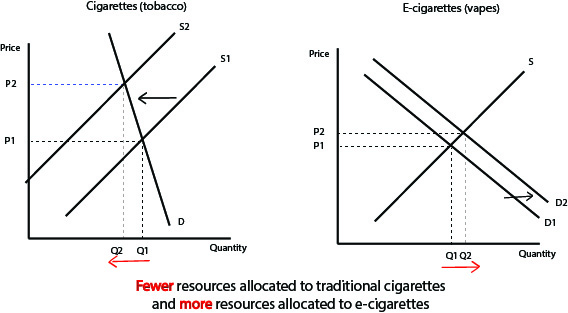Activity 2m: Vaping: The tricks and loopholes
e-cigarette and tobacco
industries use to target young people

- A potential opportunity cost is the benefit (or net benefits) that is foregone when we purchase and consume e-cigarettes, such as the benefits foregone from the consumption of healthier alternatives, which have fewer negative effects (or even positive effects if healthy options are considered).
- The law of demand in the context of e-cigarettes refers to the inverse relationship between the price of e-cigarettes and the demand for them. As the price rises, it is reasonable to expect the demand for e-cigarettes to fall and when the price falls the demand to rise. There are two primary reasons for this relationship. First, there is the substitution effect, which describes the process of consumers of e-cigarettes substituting away from e-cigarettes when the price rises and perhaps towards a substitute product such as conventional cigarettes. Second, there is the income effect. This describes the situation where a higher price of e-cigarettes results in any given level of consumer income only being able to afford a smaller quantity of e-cigarettes.
- The excise increases over recent years has resulted in a higher absolute price of traditional cigarettes and therefore a lower relative price of substitutes, like e-cigarettes. This has caused the demand for and production of tobacco products to fall (as shown by the move in Q from Q1 to Q2) in the diagram on the left as the supply curve shifts to the left because of the higher excise. In response, the demand for e-cigarettes rises, leading to a higher price and greater quantity sold on markets, as depicted in the diagram on the right, with the D curve shifting to the right because the price of a substitute has risen.

4. The profit motive is important because the higher excise raised the costs of production for tobacco producers and, therefore, reduced the profit (margin) that could be made per packet of cigarettes (as not ALL of the cost could be passed onto consumers without losing sales). This caused them to become less incentivised to allocate resources to the production of tobacco and more incentivised to allocate resources to the production of e-cigarettes, whose lower relative price encouraged greater consumption (demand).
5. This is because, like tobacco products, e-cigarettes are addictive and therefore become somewhat of a necessity for many concumers. This causes them to become relatively unresponsive to a price change. So if the price for e-cigarettes rose by 20% the demand for them is likely to fall be less than 20%, making e-cigarettes a product with a low PED.
6. This is because e-cigarettes are a durable product and can be stored for long periods of time. This means that producers can be highly responsive to an increase in the market price of e-cigarettes by supplying more to the market in a relatively short period of time.
